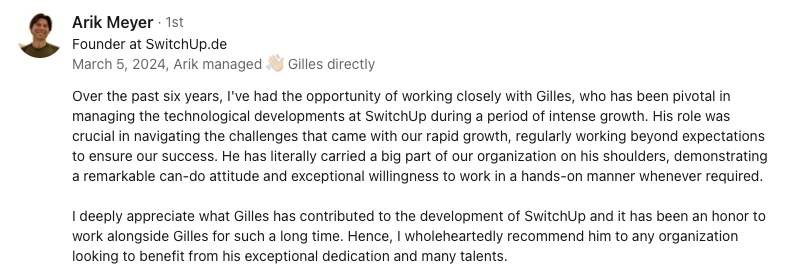Unlocking High-Performance Computing with Julia Language
Abstract:
Julia Language is gaining attention in high-performance computing (HPC) and scientific computing for its parallel processing and numerical computation capabilities, rivaling traditional languages like C, C++, and Fortran. This presents opportunities for technology and engineering leaders to drive innovation and efficiency, with potential applications in data processing, scientific simulations, and engineering workflows. Additionally, Julia's collaborative nature and extensive libraries make it suitable for cross-industry applications. Embracing Julia could lead to improved competitiveness and innovation in the evolving digital landscape.
The Transformative Potential of Julia Language in High-Performance Computing
Imagine a world where high-performance computing (HPC) isn't just the exclusive playground of seasoned experts fluent in the ancient dialects of C, C++, and Fortran. Enter Julia, a language that's stirring the pot in the HPC and scientific computing arenas with its remarkable capabilities in parallel processing and numerical computation. This dynamic and high-level language is not merely tiptoeing around the edges of convention; it's pirouetting straight through the core, offering both speed and ease of use that traditional languages struggle to provide in the same package.
Why this growing buzz around Julia, you ask? For starters, its ability to effortlessly juggle high-level code abstraction with low-level performance optimization is something akin to finding a unicorn in the tech world. Its sophisticated compiler, designed from the ground up for performance, enables Julia to tackle complex numerical and computational tasks at speeds that would make even the most seasoned C programmer's head turn. The language's inherent knack for parallel and distributed computing further sweetens the deal, positioning it as a formidable challenger in the HPC domain.
With Julia, the promise of making HPC accessible to a broader range of professionals and enthusiasts is becoming more tangible. This narrative explores the paradigm shifts Julia could incite in technology and engineering sectors, courtesy of its welcoming syntax, impressive speed, and the harmonious blend of productivity and performance. It's time to explore how this linguistic innovator is setting the stage for a new era in computational efficiency and scientific discovery.
Comparing Julia with Traditional Programming Languages in HPC
Embarking on the journey through high-performance computing (HPC) can sometimes feel like choosing the right character in a video game; each has its unique powers and weaknesses. In the digital dojo of computational performance, Julia emerges as the newcomer, ready to challenge the reigning champions: C, C++, and Fortran. But is Julia merely a flashy challenger, or does it possess the prowess to redefine the battleground? Let’s explore the face-off by looking at various aspects, including performance, ease of use, development speed, and proficiency in handling complex algorithms.
Performance Showdown
When it comes to performance, traditional languages have long been the heavyweight champions. Known for their raw power and efficiency, C, C++, and Fortran have dominated the HPC arena. However, Julia steps into the ring with a compelling proposition—combining the agility of high-level languages with the might of low-level performance. Its just-in-time (JIT) compiler performs magic, transforming Julia's elegant syntax into highly optimized machine code, closing the gap in raw computational speed that has kept other high-level languages out of the HPC spotlight.
Ease of Use: The Learning Curve
Picture this: decades-old programming languages with their intricate syntax versus Julia's modern, clean, and expressive syntax. The contrast is stark. Traditional languages, for all their power, come with a steep learning curve, akin to mastering an ancient art form. Julia, on the other hand, is the friendly mentor, guiding users with its intuitive syntax that significantly flattens this curve. This welcoming nature not only makes HPC more accessible but also opens doors to innovation and collaboration across fields.
Speed of Development: Racing to Results
In the race to results, development speed is where Julia begins to pull ahead. In traditional HPC development, the workflow often involves a tedious cycle of writing, compiling, debugging, and optimizing. Julia, leveraging its JIT compilation, streamlines this process. Dynamic typing and the elimination of the compile-link-execute cycle let developers iterate rapidly, transforming ideas into operational code at unprecedented speeds. This agility means that projects that would take months in C or Fortran could potentially be completed in weeks with Julia.
Mastering Complex Numerical Algorithms
The true test of any HPC language lies in its ability to dance with the most complex of numerical algorithms without missing a step. Traditional languages, with their long history, have built extensive libraries and routines honed for this purpose. Julia, however, does not back down. Its powerful mathematical capabilities, combined with a design that encourages the efficient implementation of numerical methods, allow for direct translation of algorithms from theory to code. The language's array handling and specialized mathematical functions are particularly noteworthy, offering a suite of tools that can simplify the traditionally convoluted process.
- Performance: While traditional languages lead in raw speed, Julia's JIT compilation closes the performance gap, making it competitive.
- Ease of Use: Julia's modern, intuitive syntax offers a stark contrast to the complex syntax of traditional languages, lowering the barrier to entry.
- Speed of Development: Julia's dynamic typing and JIT compilation significantly speed up the development lifecycle.
- Complex Algorithms: Julia's design and capabilities facilitate the direct implementation of intricate numerical algorithms, challenging traditional languages on their own turf.
In sum, while the venerable warriors of C, C++, and Fortran have their merits, Julia introduces a compelling mix of speed, ease, and flexibility. This agile contender might not overthrow the champions overnight, but it's certainly poised to win hearts (and minds) in the HPC community, proving that sometimes, the newcomer can indeed teach the old guard a few new tricks.
Exploring Innovative Applications and Benefits of Adopting Julia
Julia isn’t just a breath of fresh air in the high-performance computing scene; it’s a gust that’s blowing open doors across industries quicker than a determined cat that won’t be kept out of any room. Let’s saunter through the vast and varied landscape of Julia’s applications, touching on its significant forays into different disciplines and spotlighting the benefits this language brings to the technological tableau.
Julia's Diverse Applications Across the Spectrum
First off, the versatility of Julia language is nothing short of remarkable. Picture Julia as the Swiss Army knife in your digital toolbox—equally adept at carving through data processing tasks, as it is at sculpting scientific simulations or engineering complex workflows. This adaptability stems from its high-level syntax and powerful computational abilities, making it an attractive ally for a wide range of applications.
- Data Processing: In the world of big data, speed is king, and Julia's throne is secure. Its prowess in handling voluminous datasets, thanks to fast execution times and efficient memory management, empowers data scientists to crunch numbers with the agility of a caffeinated squirrel.
- Scientific Simulations: For researchers pushing the boundaries of discovery, Julia provides a reliable platform for simulating complex scientific phenomena—be it climate models, biological systems, or astrophysical events. The language's numerical accuracy ensures that even the most minute details aren’t lost in translation.
- Engineering Workflows: Engineers designing the next generation of marvels find Julia’s ability to integrate with existing C and Fortran libraries, alongside its native prowess in numerical problem-solving, ensures that innovation isn’t just dreamt up but brought to life, efficiently and effectively.
But it’s not just about the where and what; it’s the how and why that truly underscores Julia's appeal. Its collaborative nature lubricates the wheels of innovation, fostering a community where sharing knowledge and tools isn’t just encouraged but passionately pursued. Coupled with an extensive library ecosystem, this sense of community propels Julia into a league of its own when it comes to driving technological efficiency and creativity.
The Perks of Being a Julia Adopter
Embracing Julia comes with a lineup of enviable benefits, akin to discovering an unexpected shortcut on your daily commute that miraculously bypasses all traffic. For starters, the language's intuitive syntax and dynamic nature reduce development time from "Just give me a moment" to "Oh, I already finished," thereby enhancing productivity. Moreover, its seamless scalability from laptops to cloud-based clusters demonstrates an architectural flexibility that’s as rare as a quiet group chat.
Additionally, Julia’s compatibility with other programming languages means that it plays well in the sandbox with existing codebases, allowing organizations to transition at their own pace without upending their entire technological infrastructure. This interoperability, alongside Julia’s stellar computational efficiency, positions it as a strategic asset for any team looking to elevate their high-performance computing capabilities without sacrificing speed for simplicity—or vice versa.
In the grand scheme, adopting Julia isn’t just about leveraging a programming language with impressive computational chops; it’s about joining an ecosystem geared towards fostering innovation, efficiency, and collaboration. And if those aren’t winning tickets in the tech world, what are?
The Strategic Advantage of Embracing Julia in the Digital Age
To wrap things up neatly, like the concluding chapter of your favorite mystery novel, let's recount the adventure we've embarked on with Julia. This journey through the dynamic world of high-performance computing (HPC) with Julia as our guide has unveiled a landscape brimming with possibilities. It's clear that the Julia language is not just another contender in the ring of programming languages; it's a game-changer poised to redefine the field of technology and engineering.
The narrative so far has illustrated Julia's ability to stand toe-to-toe with heavyweight champions like C, C++, and Fortran, offering a compelling mix of lightning-speed performance, intuitive ease of use, and the kind of flexibility that makes software developers' hearts sing. Whether it's the rapid development cycles that make pressing deadlines seem like a breeze, the seamless handling of complex numerical algorithms that would otherwise require a Herculean effort, or the collaborative ecosystem that nurtures innovation like a well-tended garden, Julia's strategic advantages are clear.
Adopting Julia translates to more than just a technological upgrade; it's about positioning oneself at the frontline of the digital revolution. With its unmatched efficiency and versatility, Julia equips technology and engineering professionals with the tools to drive forward innovation, tackle complex problems with newfound agility, and improve competitiveness in a digital world that waits for no one. Its architectural prowess, allowing graceful scaling from a single laptop to cloud-based clusters, showcases a rare blend of power and pragmatism, making Julia an invaluable asset for anyone looking to elevate their HPC game.
So, as we close this chapter, it's evident that Julia isn't just helping write the future of high-performance computing; it's offering us the pen. For those ready to harness the opportunities of the digital frontier, Julia appears not just as a choice but as a beacon, illuminating the path towards innovation, efficiency, and collaborative success in the technological realm. The question isn't whether Julia can revolutionize your computational tasks—it's how far you're willing to let it take you.













